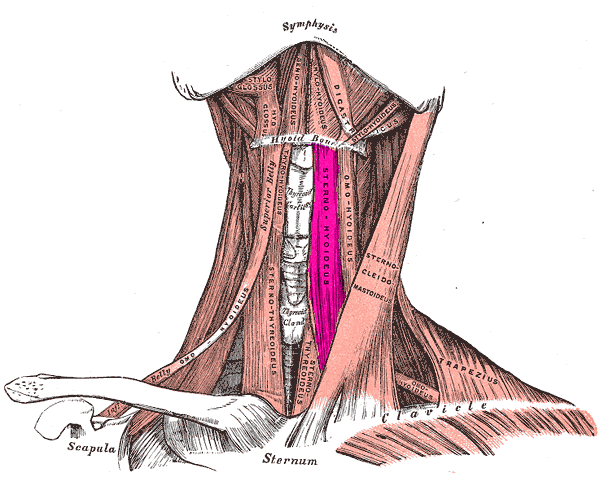[2]
Sreedharan R, Krishna L, Shetty A. Origin of superior thyroid artery: under the surgeon's knife. Jornal vascular brasileiro. 2018 Oct-Dec:17(4):290-295. doi: 10.1590/1677-5449.004218. Epub
[PubMed PMID: 30787946]
[3]
Meguid EA, Agawany AE. An anatomical study of the arterial and nerve supply of the infrahyoid muscles. Folia morphologica. 2009 Nov:68(4):233-43
[PubMed PMID: 19950073]
[4]
Sun G, Wang Y, Zhu Y, Wang Y, Xu K, Wei W, Li H, Lu Z, Ji Q. Lymph node metastasis between sternocleidomastoid and sternohyoid muscle in clinically node-positive papillary thyroid carcinoma. Head & neck. 2013 Aug:35(8):1168-70. doi: 10.1002/hed.23099. Epub 2012 Aug 28
[PubMed PMID: 22927223]
[5]
Prades JM, Gavid M, Dubois MD, Dumollard JM, Timoshenko AT, Peoc'h M. Surgical anatomy of the ansa cervicalis nerve: which branch to use for laryngeal reinnervation in humans? Surgical and radiologic anatomy : SRA. 2015 Mar:37(2):139-45. doi: 10.1007/s00276-014-1355-x. Epub 2014 Aug 28
[PubMed PMID: 25165021]
[7]
Hantzakos A, Evrard AS, Lawson G, Remacle M. Posthemicricoidectomy reconstruction with a composite hyoid-sternohyoid osseomuscular flap: the Rethi-Ward technique. European archives of oto-rhino-laryngology : official journal of the European Federation of Oto-Rhino-Laryngological Societies (EUFOS) : affiliated with the German Society for Oto-Rhino-Laryngology - Head and Neck Surgery. 2007 Nov:264(11):1339-42
[PubMed PMID: 17571274]
[8]
Dong P, Li X, Xie J, Li L, Xu H. Modified frontolateral partial laryngectomy without tracheotomy. Otolaryngology--head and neck surgery : official journal of American Academy of Otolaryngology-Head and Neck Surgery. 2009 Jul:141(1):70-4. doi: 10.1016/j.otohns.2009.02.007. Epub 2009 Apr 9
[PubMed PMID: 19559961]
[9]
Dong P, Li X, Wang G, Chen X, Xie J, Nakashima T. Repair with sternohyoid muscle fascia after subtotal laryngectomy. The Journal of laryngology and otology. Supplement. 2009:(31):18-23. doi: 10.1017/S0022215109005039. Epub
[PubMed PMID: 19460199]
[10]
Icibaci A, de Mello-Filho FV. Tracheal transplant with a prefabricated microsurgical flap. The Laryngoscope. 2009 Dec:119(12):2309-14. doi: 10.1002/lary.20538. Epub
[PubMed PMID: 19768763]
[11]
Alam DS, Haffey T, Vakharia K, Rajasekaran K, Chi J, Prayson R, McBride J, McClennan G. Sternohyoid flap for facial reanimation: a comprehensive preclinical evaluation of a novel technique. JAMA facial plastic surgery. 2013 Jul-Aug:15(4):305-13. doi: 10.1001/jamafacial.2013.287. Epub
[PubMed PMID: 23702665]
[12]
Kim JS, Hong KH, Hong YT, Han BH. Sternohyoid muscle syndrome. American journal of otolaryngology. 2015 Mar-Apr:36(2):190-4. doi: 10.1016/j.amjoto.2014.10.028. Epub 2014 Oct 22
[PubMed PMID: 25484367]
[13]
Tecchio SA, de Mello-Filho FV, Martins Mamede RC, Llorach Velludo MA. Time necessary for neovascularization of a tracheal segment by the sternohyoid muscle. Otolaryngology--head and neck surgery : official journal of American Academy of Otolaryngology-Head and Neck Surgery. 2001 Sep:125(3):201-4
[PubMed PMID: 11555754]

